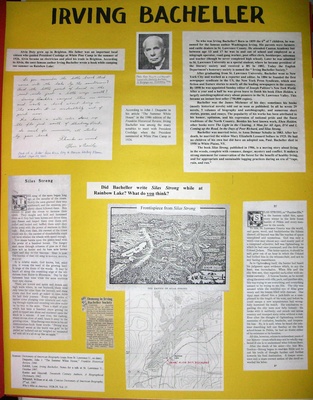 "Irving Bacheller" by Pat and Tom Willis, photo of display taken 2/2009. Click on the image to enlarge the display.
"Irving Bacheller" by Pat and Tom Willis, photo of display taken 2/2009. Click on the image to enlarge the display.
Irving Bacheller
According to John J. Duquette, in his article The Summer White House, in the 1986 edition of the Franklin Historical Review, Irving Bacheller was among the many notables to meet with President Coolidge when the President summered at White Pine Camp in 1926.
Born in 1859, the sixth of seven children, Irving Bacheller was named for the famous author Washington Irving. His parents were farmers and cattle dealers in St. Lawrence County. He attended Canton Academy but, between the ages of 13 and 17, he was in and out of school and employed as a telegraph operator, road gang worker, postal clerk, bookkeeper, salesman and teacher (although he never completed high school.) Later he was admitted to St. Lawrence University as a special student, where he became president of the literary society and received a B.S. in 1882. Today the English Department's honorary society is named the “Irving Bachellor Society.”
After graduating from St. Lawrence University, Bachellor went to New York City and worked as a reporter and editor. In 1884 he founded the first newspaper syndicate in the U.S., the New York Press Syndicate, which sent fiction and feature stories to nearly all the leading newspapers in the country. By 1898 he was appointed Sunday Editor of Joseph Pulitzer's New York World. After a year and a half he was given leave to finish his book, Eben Holden, a largely autobiographical story about pioneers in the St. Lawrence Valley. This became an instant best seller (750,000 copies.)
Bacheller was the James Michener of his day: sometimes his books (mostly historical novels) sold out as soon as published. In all he wrote 29 novels, 5 volumes of biography and autobiography and numerous short stories, poems and essays. The popularity of his works has been attributed to his humor, optimism and expression of national pride and the finest traditions of the North Country. Besides his best known work, Eben Holden other books were The Light in the Clearing, A Man for All Ages, D'ri and I, Coming Up the Road, In the Days of Poor Richard, and Silas Strong.
The book Silas Strong, published in 1906, is a moving story about living in the woods, complete with romance, danger, mystery and conflict. It makes a strong statement for conservation of the forest for the benefit of healthy living, and for appropriate and sustainable logging practices during an era of “rape, ruin and run.”
Bacheller was married twice, first to Anna Detmar Schultz in 1883 and after her death, he married the widow Mary Elizabeth Leonard Sollace in 1925. He had no children of his own but he did have an adopted son, Paul. Bachellor died in 1950 at White Plains, NY.
Sources: Dictionary of American Biography. (Copy from St. Lawrence University, no date.) Duquette, John J. “The Summer White House,” Franklin Historical Review, 1986 Eckfelt, Lynn. Irving Bacheller. Notes for a talk at St. Lawrence University, October 1997 Kunitz and Haycraft. Twentieth Century Authors: A Biographical Dictionary. 1942 Whitehill, William et al, eds. Concise Dictionary of American Biography. 2nd Ed, 1997 Who's Who in America 1928-29. Vol. 15.
Brighton History Days have been held one weekend each summer since 1994, sponsored by the Brighton Architectural Heritage Committee.



